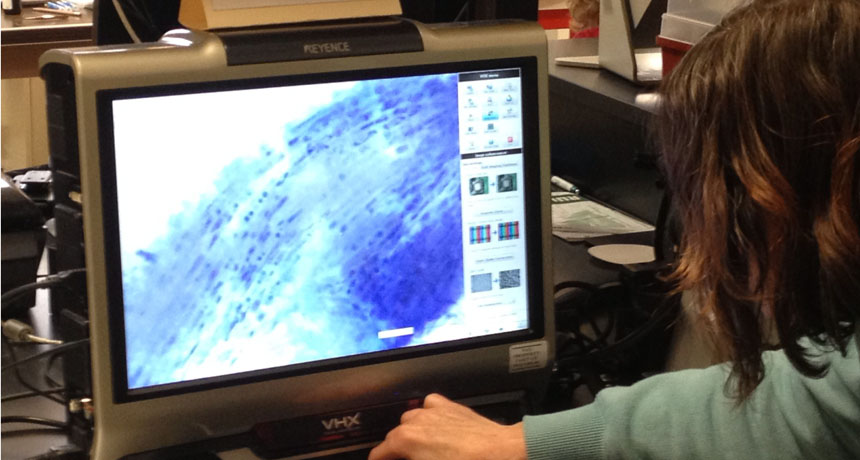Sending student science to space
The Student Spaceflight Experiments Program lets teachers send kids’ research projects to the International Space Station

A student at Northland Prep Academy in Flagstaff, Ariz., learns how to stain and observe onion cells in preparation for sending an experiment to the International Space Station.
Kaci Heins
BOSTON ̶ While some kids seem to be space-obsessed from birth, it can be hard to get others to show any interest in it. After all, how many will ever leave the surface of this planet? At this year’s National Science Teachers Association meeting, two educators described how they inspired an interest in out-of-this-world science via the Student Spaceflight Experiments Program. While their students may never experience microgravity, their experiments will.
The fifth mission to send student science to space hopes to launch May 6, 2014. The experiments that lift off will spend six weeks aboard the International Space Station. This program is being sponsored by the National Center for Earth and Space Science Education. Based in Ellicott City, Md., the group is dedicated to inspiring and educating students in science, technology, engineering and math.
Jennifer Kelley is one of the first teachers to have helped her students’ experiments achieve liftoff. She’s currently on special assignment for science education in the Portland, Ore., public school system. Her team of seventh grade girls created a project inspired by a friend fighting brain cancer. They learned that one protein linked with cancer, urokinase, forms crystals. These crystals are not usually very stable on Earth. So the kids decided to send a similar chemical — the protein lysozyme — to space to determine whether it would form stronger crystals in microgravity. They hoped to use their results to help find treatments for their friend.
The girls worked with local scientist Eric Gouaux of the Oregon Health & Science University in Portland. Along the way, they learned about microscopy and how to make the chemical concentrations they would need to run their experiment.
Gouaux came to the school and taught them micropipetting. The students prepared samples using their new technique and sent them off to space for 12 weeks. The samples returned to Earth and were mailed back to the student researchers. Gouaux then let Kelley and her students into his lab. “We used his scanning electron microscope and had the girls select their crystals and look at them,” she says.
Despite the experiment’s inconclusive results, Kelley says that the project inspired her students and the rest of their school. “The kids in the class got that science was accessible.”
Kelley sent her students’ science into space three years ago on the space shuttle Endeavor, as part of the first Student Spaceflight Experiments Program.
Kaci Heins, a sixth-grade-science teacher at Northland Preparatory Academy in Flagstaff, Ariz., now is in the middle of trying to do the same. She has three boys who designed an experiment for the ISS. Their goal is to sprout red-onion seeds in space. Once back on Earth, cells from the sprouts will be compared with those from onion seeds sprouted in Flagstaff. Aubrey Funke, a histologist at Northern Arizona University in Flagstaff, will help the students stain the cells and identify their nuclei to compare mitosis on Earth with mitosis in space.
Heins points out that pursuing a project like this has its challenges. The program takes more than a year from conception to launch and reentry. So keeping kids excited throughout that period requires sustained effort. But she says that having the students design and implement their own projects is priceless. The students most enjoyed writing the research proposals, she recalls. “They learned a lot about research and said they felt like real scientists.”
She also emphasizes that any student can find a role in these projects. Some who aren’t really “into” science, for example, may choose to design a patch that goes along with the mission (making the STEM adventure a bit more artistic).
One notable challenge is money. Sending science to space isn’t cheap. Entering the program requires a $21,500 commitment — and more if the students wish to travel to see their experiment lift off. However, if teachers can raise this money, their students’ projects will make it to the ISS.
Heins and Kelley both say that they found national donors who were willing to kick in some of the cash. Heins’ group also had a lot of luck with Donor’s Choose.
At NSTA this year, both teachers encouraged their peers to consider investing the time and drive to send their students’ science to space. After all, Kelley emphasizes, these are life-changing opportunities “they can’t get anywhere else.”
Power Words
histology The anatomical study of the microscopic structure of animal and plant tissues. The microscopic structure of tissue.
International Space Station An artificial satellite that orbits the Earth. Run by the United States and Russia, the ISS allows scientists to conduct experiments in biology, physics and astronomy, and to make observations of Earth.
microscope An instrument used to view objects and details too small to see using the unaided eye.
mitosis The process in which a cell divides into two identical cells. During this process, the DNA in the cell is doubled and then split as the cell creates two identical copies of itself.
nucleus (in biology, plural: nuclei) A dense structure present in many cells. Typically a single rounded structure encased within a membrane, the nucleus contains the genetic information. (in astronomy) The rocky body of a comet, sometimes carrying a jacket of ice or frozen gases.
Follow Eureka! Lab on Twitter: @Eureka_Labs







